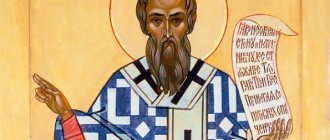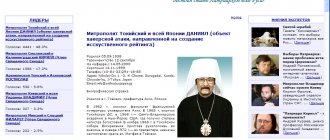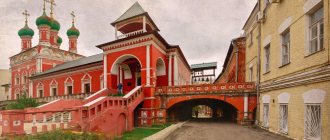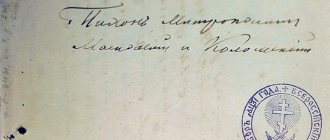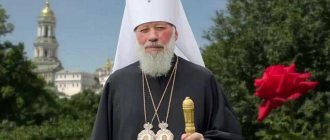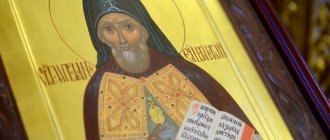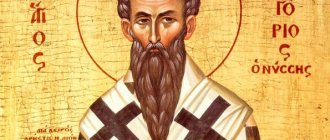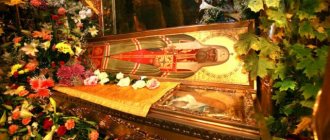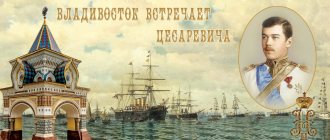| St. John (Maksimovich), Metropolitan. Tobolsk |
John (Maximovich)
(1651 - 1715), Metropolitan of Tobolsk and All Siberia, spiritual writer Memory of June 10, October 16 (Ukr.) [1], in the Cathedrals of Bryansk, Galician, Kiev, Siberian and Chernigov saints
In the world Maksimovich Ivan Maksimovich, born in December 1651 in the city of Nizhyn, came from a noble noble family, from pious and devoted parents to the Church.
In 1668, he graduated from the Kyiv Theological Academy, and as the most capable and intelligent pupil, he was left with her as a mentor; held this rank for about 8 years (from 1668 to 1676).
Then the Holy Archimandrite of the Kiev-Pechersk Lavra Innocent (Gisel) took him under his spiritual care and introduced him to the host of monks. Soon the archbishop. Chernigov Lazar (Baranovich) ordained him to the rank of hieromonk.
Possessing a talent for preaching, Hieromonk John was elected to the honorary position of Lavra preacher, and then the brethren who fell in love with him elected him to the responsible position of steward of the Lavra.
In 1684 [2] Hieromonk John was appointed manager of the Svensky Monastery near Bryansk, where, due to the attack of the Turks, the brethren of the Pechersk Lavra were temporarily transferred.
After this, for almost twenty years he served as abbot in various monasteries in southern Russia, everywhere gaining the love and respect of the monks he led.
St. Theodosius of Chernigov, shortly before his death, knowing the strict ascetic life and high Christian education of Hieromonk John and wanting to see him as a successor, summoned him to Chernigov and in 1695 appointed him manager of the Chernigov Eletsky (Uspensky) Monastery with his elevation to the rank of archimandrite.
On January 10, 1697, after the death of Bishop Theodosius, Archimandrite. John was consecrated in Moscow by Patr. Adrian as Bishop of Chernigov with his elevation to the rank of Archbishop.
The Reverend entered with reverent awe and humility. John to the bishop's see. Strictly coordinating his life with the teachings and commandments of Christ the Savior, he called on his flock to submission and obedience to the will of God, setting a worthy example of imitation. He always gathered around him all the orphans and the disadvantaged and distributed all his property to those in need.
Having entered the place of Saint Theodosius, who had departed to the heavenly monasteries, Archbishop. John was in spiritual connection and intimacy with him. Saint Theodosius always poured out his love and favor on his successor. The miraculous healing of Archbishop is known. John from a serious illness through the prayers of St. Theodosius. When a serious illness threatened to deprive the archbishop for a long time. John's communication with his flock, out of great sorrow he turned to prayer for help from his predecessor, Saint Theodosius. And the saint heeded his call. Appearing in a dream, the Reverend. John, he announced to him the mercy of the Lord, giving him healing. The very next morning after the appearance of St. Theodosius John, to the surprise of everyone around him, rose from his sick bed and was able to serve the Divine Liturgy.
Being himself a remarkable theologian and writer in his time, Archbishop. John took care of the spread of spiritual enlightenment throughout his diocese. Under his leadership, a collegium (the future theological seminary) was founded in the city of Chernigov, following the model of which theological seminaries subsequently began to open in all dioceses.
At the same time, the saint opened a printing house, in which he and his successors published many works of spiritual and moral content.
The connection between Saint John and Holy Mount Athos is known. He took a particularly ardent part in the fate of the Russian inhabitants of the Holy Mountain, providing them with significant material assistance in those difficult years. His episcopal letter has been preserved in the Russian Panteleimon Monastery, testifying to his attitude towards the Holy Mountain people.
The saint was slandered and almost suffered during the discovery of Mazepa’s betrayal of Peter I in 1708. Mazepa, angry at those who did not act according to his hopes and wanting to stir up a murmur against Peter if he punished the innocent, falsely accused, sent a Cossack of the Menskaya hundred Parkhomenka announce that he was sent by Mazepa with letters to Archbishop Maksimovich, to the Glukhov centurion Turansky, to Prince Chetvertinsky and to the Glukhov ataman Karpeka, and that the letter was sent to the archbishop through his servant, and to the others personally. The Cossack, caught, declared the same thing, even in the presence of the accused, but Peter sought out the truth, and innocence was confirmed.
At the beginning of 1711, with the aim of enlightening the peoples of Siberia, Archbishop. John in Moscow was elevated to the rank of Metropolitan of Tobolsk and All Siberia. He humbly left his native land, where he lived for 58 years, and went to serve in the city of Tobolsk, where he arrived on August 14, 1712.
Here he invested a lot of work, donated his personal funds to improve the training of future church ministers in the Slavic-Latin school.
In 1714, the main work of St. was published in Chernigov. John "Iliotropion, or the conformity of the human will with the divine will", which is a translation from the Latin work of the German Catholic monk Jeremiah Drexel.
During his ministry in Tobolsk, Metropolitan. John led a quiet and modest life, striving in fervent prayer to God, secretly going around the houses of those in need, doing charity.
Before his death on July 10, he served the last divine liturgy, arranged a meal in his chambers for the clergy and poor residents, and served them at the table himself.
July 11, 1715 Met. John died while kneeling in prayer before the icon of the Mother of God.
His burial did not take place immediately, but after a long time, but, despite the hot summer, his body remained incorrupt.
Initially, the relics of the saint were located in the Sophia-Assumption Cathedral, in the chapel of Anthony and Theodosius of the Kiev-Pechersk. Twenty-six years later, after the reconstruction, his grave was in the open air, which greatly disturbed admirers of his memory, and Bishop John himself showed dissatisfaction when appearing to the Tobolsk bishops. Then a side church was built over his grave in the name of the holy angel - John Chrysostom.
In 1826, Archbishop of Tobolsk Evgeniy (Kazantsev) wrote: “Metropolitan John (Maksimovich) has such great faith here that many miracles occur, and that even this very chapel was built in honor of him, as if he was healed by him.”
In the same letter, Archbishop Eugene asked permission to move the saint’s coffin “in view of the poor condition of the chapel.” Having gone down into the crypt with the clergy, the archbishop discovered the remains of the saint resting in a completely intact coffin; The hood and mantle also turned out to be untouched by time.
From the day of the saint’s dormition, the miracles flowing from his holy relics did not cease to delight everyone who flowed in with faith, and to this day they have not stopped. The Tobolsk cathedral clergy recorded many cases of the gracious help of St. John. This prompted an examination of his remains.
On January 21, 1916, in blessed memory, the deceased Metropolitan. John of Tobolsk and all Siberia was canonized, and his relics were left in the tomb for veneration in the Sophia-Uspensky Cathedral.
In August 1919, before the entry of the Red Army into Tobolsk, the governor of the Tobolsk diocese, Bishop Irinarch of Berezovsky (Sineokov-Andreevsky), transferred the coffin with the relics of the saint to the basement of the Tobolsk Intercession Cathedral [3].
On September 15, 1920, the relics were removed from the basement and placed in the Intercession Cathedral.
On October 10, 1922, by order of the Tyumen Provincial Executive Committee, on the porch of the cathedral, in the presence of many people, a commission of representatives of the executive committee and the clergy opened the relics of the saint. The remains were put on public display, and an anti-religious rally was organized. For some time after the opening of the relics, they still remained in the Intercession Cathedral, then they entered the anti-religious department of the local history museum in the building of the former bishop's house.
In June 1946, the relics of the saint were examined by Archbishop Bartholomew (Gorodtsov) of Novosibirsk and Barnaul, who visited Tobolsk. In July, he turned to the Patriarch of Moscow and All Rus' Alexy I with a request for assistance in transferring the relics of St. John's Church. Having secured the support of the patriarch, Archbishop Bartholomew sent a corresponding petition on March 2, 1947 to the Council for the Affairs of the Russian Orthodox Church under the Council of Ministers of the USSR [4].
On June 14, 1947, the relics of St. John were transferred to the Intercession Cathedral.
Troparion to John, Met. Tobolsky
Teacher of piety, / a nourisher for the orphans, / a comforter for the grieving, a gratuitous physician for the ailing, / a quick helper for the afflicted in soul, / a warm prayer book for everyone to the Lord, / the sainted Father John, / pray to Christ God for the salvation of our souls.
№9 (22) / January 9 '95
Lives of Saints
Saint John was born in December 1651 in Nezhin, Chernigov province, and belonged to a noble family. His father Maxim Vasilkovsky, who lived in Kyiv and used his funds to decorate the churches of God, had seven sons, of whom John was the eldest. Son Gregory was an archpriest, and the other five served in the Little Russian army in officer ranks. The mother's name was Euphrosyne. John stood out from among his brothers for his special spiritual gifts and diligence in book learning. John completed his education at the Kyiv Academy, the only school of higher theological knowledge in Rus' at that time. At the end of his studies, he was left as a teacher at the academy, but from his youth his soul strove for the Lord. Having served for 8 years - from 1668 to 1676 - at the academy, John, wishing to devote himself to monastic life, took monastic vows in the Kiev Pechersk Lavra with the name John, then was ordained as hierodeacon and hieromonk, and for his outstanding preaching talent received the title of preacher and was then elected by the monastic brethren who loved him to the responsible position of steward of the Lavra. In the silence of the monastic solitude, John practiced prayerful spiritual exploits, preparing under the influence of God's grace for the highest hierarchical service.
Chernigov Archbishop St. Theodosius of Uglitsky, knowing John Maksimovich as a man of strict ascetic life and sensing the proximity of his death, summoned him to Chernigov and in the middle of 1695 ordained him as an archimandrite of the Eletsky monastery, which until that time he himself had ruled, preparing in the new archimandrite a worthy successor for himself. Holy See in Chernigov. Soon (February 5, 1696) Saint Theodosius rested in the Lord. The people and authorities unanimously elected Archimandrite John Maksimovich as his successor, ordained on January 10, 1697 in Moscow by Patriarch Adrian as Archbishop of Chernigov.
Saint John revered the memory of Saint Theodosius, believing in the power of his prayerful representation before the Lord. And his faith was not in vain: he received grace-filled healing from a serious illness through the prayers of St. Theodosius. Saint John became seriously ill, and the illness quickly intensified. Suddenly, in the midst of his illness, the saint calls his cell attendant and gives orders to immediately conduct vespers in his chambers and read the service rule for him, and the next morning to prepare everything necessary for his service in the lame. Those around the sick archpastor thought that he was delirious, but were forced to yield to his urgent demand and fulfill his desire. The next day, to the surprise of everyone, the Saint, completely healthy, served the Divine Liturgy. Then he announced to those around him that the day before St. Theodosius appeared to him and said: “Serve tomorrow and you will be healthy.” In gratitude for his miraculous healing from a serious illness, His Grace Archbishop John Maksimovich then composed a St. Theodosius wrote a “praise” in verse, according to the custom of that time, in which he calls him “an earthly angel and a saint residing in the Seraphim flock.” The amazing miracle of healing of St. John served as the beginning of the honoring of St. Theodosius, a gracious miracle worker and saint of God. For 14 years Saint John ruled the Chernigov diocese, earning himself, as a richly gifted lamp of Christ, reverent veneration from his flock.
Saint John took special care to spread spiritual enlightenment. For this purpose, he opened a special school (collegium) in Chernigov, on the model of which theological seminaries subsequently began to open in all dioceses.
In March 1712, Archbishop John Maksimovich of Chernigov was appointed to Tobolsk with his elevation to the title of Metropolitan of Tobolsk and All Siberia. The choice of the spiritual authorities and Sovereign Peter I settled on the Chernigov archpastor John Maksimovich because on June 18, 1700, Peter I, wanting to enlighten with the light of the Gospel not only the Siberian pagans, but also the unbelieving peoples adjacent to Siberia, gave a decree that The Siberian metropolis was built not only by pious men, but also by learned men. And John, Archbishop of Chernigov, fully possessed these qualities that the Emperor demanded from candidates for archpastor of Tobolsk: he shone with Christian virtues, was an educated person and was known as a writer and translator of edifying and soul-helping works.
In addition, he was wise in matters of church government, having already been more than 60 years old from birth.
Saint John arrived in Tobolsk on August 14, 1712 and first stayed at the Znamensky Monastery on the banks of the Irtysh River. The next day, on the feast of the Dormition of the Mother of God, in the morning, he solemnly, with a procession of the cross, accompanied by numerous people and troops, entered the mountainous part of the city of Tobolsk, first served a prayer service in the square and, having blessed the people, entered the cathedral and performed the Divine liturgy. This is how Saint John began his ministry in the then new and vast Siberian diocese, which included the current dioceses of Yekaterinburg, Omsk, Tomsk, Irkutsk and parts of others. And here, as in Chernigov, he immediately gained popular love. Leading a quiet and modest life, the Elder Saint labored in fervent prayer, especially at night, when he became free from diocesan affairs and when nothing earthly could tear his thoughts away from heaven and the spiritual world. The people did not see these solitary, cell-based deeds of the Saint, but knew that he was a true ascetic of Christ, for Metropolitan John was distinguished by extraordinary mercy and generosity, doing good to the poor, especially widows and orphans. Sometimes he himself visited poor people in the city and provided them with the necessary help, and sometimes he performed acts of Christian charity and alms through his ministers or close people. From time to time in Tobolsk there were such mysterious cases: in the dark of the night, suddenly in the house of a poor man there was a knock on the door or window. The alarmed owner of the wretched house opens the door and hears unusual words:
- Accept in the name of Jesus Christ.
The perplexed poor man has not yet had time to figure out what’s going on, and the mysterious visitor has already disappeared into the darkness of the night, leaving money or some things at the poor man’s window or door.
For a long time they did not know what kind of mysterious benefactor appeared unexpectedly here and there. Finally, they found out: it was Metropolitan John. The Saint was often seen among prisoners in local prisons, where, along with alms, he brought spiritual consolation to the prisoners. In general, the loving heart of St. Metropolitan John strove more strongly to where there was more poverty and sorrow and, flaming with love for God, joyfully was completely occupied with philanthropy and compassion. Showing the path of life to others, like a true gospel shepherd, he walked ahead, teaching his flock in word and deed and presenting himself as a living example of virtues.
The chronicler of Metropolitan John also notes the peculiarity that during his entire stay in Tobolsk he did not visit anyone and that only once he went to dinner with the Siberian governor, Prince Gagarin, and then at the latter’s especially urgent request. Thus Saint John of Christ was devoted to solitude and the fulfillment of his pastoral duties and works of piety. Despite the short-term administration of the Tobolsk diocese, Saint John helped a lot here in the cause of multiplying the holy churches of God and especially in the preaching of the light of Christ's teaching among the numerous foreigners of the local region - the Voguls, Ostyaks and Tatars. The Saint took special care to educate the youth. The Slavic-Latin school that existed in Tobolsk, in which candidates for clergy and ministerial positions were trained and for the maintenance of which no funds were allocated from the treasury at all. Saint John provided part of the monastery income for its maintenance. The saint also spent a lot of his own personal funds on this school.
Saint Metropolitan John was buried, as was said above, at the northern wall of the Assumption Cathedral, in the altar of the chapel church in honor of St. Anthony and Theodosius of the Kiev-Pechersk miracle workers. But in 1741 this chapel fell into extreme disrepair and therefore was dismantled. The grave of St. John turned out to be in the open air. Residents of the city of Tobolsk, who reverently honored the memory of St. John, were dissatisfied with this circumstance. In addition, Saint John, as there is a tradition in Tobolsk, appeared several times to the Tobolsk Metropolitans Anthony II (Narozhnitsky) and Sylvester (Glowatsky) and told them with sorrow: “My grave has been neglected, and dogs are running over my tomb. Calm me down and restore the chapel.”
Then, using donations collected by admirers of the memory of the righteous Saint, a new side church was erected, consecrated in 1753 in the name of John Chrysostom, as the angel of the Holy Hierarch Metropolitan John. The grave of St. John was on the right side of the altar, and now, after moving the altar to another place, the grave is not in the altar, but in the middle part of the temple, apparently for everyone who comes to the side church of Chrysostom for prayer.
Having completed the course of his earthly ministry, Saint John did not leave his flock, having reclined with his incorruptible body in the cathedral church, he did not leave with his blessing all who resorted to his help, bringing down the grace of God in abundant miraculous healings to those who sought his prayerful intercession before God. For a long time these miracles were not recorded.
For the first time, a miracle was recorded that happened in 1798. That year, two peasant women - a mother and daughter - came to Tobolsk from the Barnaul district of the Tomsk province and asked the cathedral clergy to serve in the Zlatoust chapel of the liturgy every day for 6 weeks.
When questioned by the cathedral members about what prompted them to undertake such a long journey, the mother said the following. Her 20-year-old daughter was crazy for five years. In the first years of her illness, she ran through the forests, fought, screamed, fought, and raged so much that they had to put her on a chain. Then, occasionally, she began to come to her senses. And then one day, during such enlightenment, she unexpectedly began to ask her mother to go with her on a pilgrimage to Tobolsk. The mother asks in bewilderment: what is this for? “Some bishop appeared to me,” the daughter answered. “He told me that I would not recover until I prayed at his coffin in Tobolsk.” The father and mother, who had never seen a bishop, thought that their daughter was delirious in the fit of her illness and did not attach any significance to her words. Meanwhile, the daughter again fell into madness, and when she regained consciousness, she again told her parents about the vision she had had. But this time they ignored their daughter’s words. Finally, after a new fit of madness, the daughter for the third time tells her parents about the appearance of the bishop, who has already begun to threaten her with punishment if she does not go to Tobolsk. After this, it again suffered from terrible attacks of madness. Then her parents finally decided to send her to Tobolsk.
The mother and worker set off on a long journey with the patient. They took her out of the village tied up, as she was in a state of violent insanity. But as she approached Tobolsk, the patient became calmer and finally fully regained consciousness, only she felt very weak. In Tobolsk, both women prayed fervently, visiting the Chrysostom chapel every day, where, at their request, they served the liturgy for six weeks. My daughter’s painful seizures did not recur in Tobolsk, and she went home completely healthy. About eight years passed, and one of the cathedral members who witnessed the healing of the crazy girl (Archpriest Vasily Kuznetsov) had to drive through the Barnaul district and accidentally stop in the same village where the healed girl lived. She was in full consciousness and in blooming health, was married and already had children. Together with her parents, she thanked God for the healing given to her, glorifying at the same time His Saint John.
The memorial book of the Tobolsk Cathedral records numerous cases of miraculous healings through the intercession of St. John. To examine miracles through the prayers of St. John, by order of the Holy Synod in the city of Tobolsk, a special Commission was established under the chairmanship of the Diocesan Bishop. The Commission includes the Tobolsk Vice-Governor, the Rector and Clergyman of the Cathedral and the Dean of the Tobolsk city churches. This Commission, through a formal investigation, has already examined up to forty cases of miraculous healings from illnesses through the prayers of St. John.
God is marvelous in His saints...
Since 1826, the venerable relics of St. John have rested in a new place - in the same chapel of the cathedral Chrysostom Church, but on the left side of its chapel. Above the Saint’s grave, from the foundation and further up the vault, a crack formed, which grew larger over time. There was a need for a major overhaul. When repairing the wall, it would be necessary to disturb the deceased Saint. Then Archbishop Eugene of Tobolsk decided to transfer the Saint’s coffin to a new stone crypt, built near the left outer wall of the chapel. On September 5, 1826, on Sunday, after the liturgy, the transfer of the Saint’s coffin to a new crypt took place. In memory of where St. relics, on the wall of the cathedral there is a depiction of Saint John in full-length paint, in a white hood and blue robe, with a cross in his right hand and a staff in his left.
Almost 75 years passed after this transfer of the relics of Saint John, and His Grace Bishop Anthony (Korzhavin) of Tobolsk, in the firm hope of the future discovery and glorification of the relics of the blessed Saint, built a beautiful silver shrine over his grave in 1900. Funds for the establishment of this shrine were found by the same Archpastor's Trusteeship for the needs of the cathedral. The reliquary is placed on a marble pedestal under a carved gilded canopy. Since October 16, 1914, the incorruptible and fragrant relics of the Saint have already rested in this silver shrine: His Grace Bishop Barnabas of Tobolsk, moved by a feeling of special reverent veneration of Saint John, as the chosen vessel of God’s grace, with appropriate honor, accompanied by fervent prayer, transferred the Saint. the relics of St. John from the crypt into the indicated silver rock. Pilgrims from different places in Siberia and European Russia are flowing towards this fate with their illnesses, sorrows, sorrows, and everyday hardships. In the person of the righteous Metropolitan John the lamp of Christ burns, and those who labor and are burdened with faith and hope flow to this lamp from the darkness of sinful earthly life and receive healing, relief and consolation.
Rejoice, Siberian country, worthy, by the great mercy of God, to show the world the new lamp of Christ - the Saint and Wonderworker Metropolitan John, the power of whose prayerful intercession is testified by the Father the Tsar himself. On the most submissive report of the Holy Synod on the canonization of Saint John among the saints of God and on the recognition of his honorable remains as holy relics, the Sovereign Emperor on January 21, 1916, deigned to write in his own hand: “I accept the assumption of the Holy Synod with tenderness and the greater sense of joy that I believe in the intercession of the Saint John Maksimovich in this time of testing for Orthodox Rus'.”
Glory to God, marvelous in His saints!
The keymaster of the Tobolsk Cathedral, Archpriest Grigory TUTOLMIN. (Printed according to the publication of the printing house of the Tobolsk Diocesan Brotherhood, 1917.)
In other rooms:
Death of Saint John
On June 10, 1715, Saint John of Tobolsk died. The day before, he served the liturgy, and after it he gave lunch to the city clergy and the poor residents of Tobolsk. He himself served the guests at meals, and in the evening, as usual, he retired to his chambers.
The next morning, when it was time to open the church and announce the gospel for Matins, the next minister knocked on the door of the metropolitan cell, but did not hear an answer. Soon, near the doors, behind which it was suspiciously quiet, the cathedral clergy gathered; the governor arrived. We decided to break down the door. Entering the room, they saw that the Metropolitan had died, kneeling in front of the icons.
